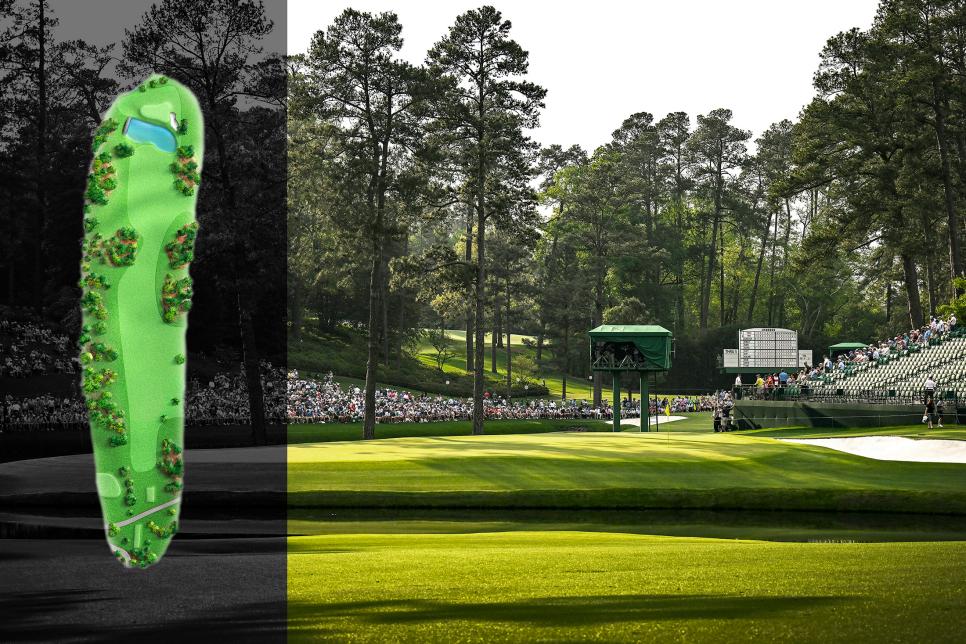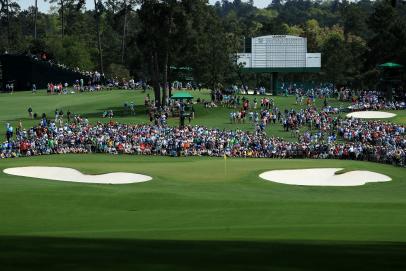
Augusta National's par-5 13th is routinely considered one of the greatest holes in golf, and who can argue? The tee has been moved back in recent years and the rear of the green and quartet of bunkers have seen upgrades, but the hole is largely as MacKenzie and Jones found and designed it in 1931.
For impact in determining Masters outcomes, however, a case could be made that the par-5 15th is more pivotal. Like 13, it’s a reachable par 5—really a par 4½—that can produce late-game eagles and swing fortunes for those steeled enough to hit and hold a long second shot over the pond that fronts the green.
Gene Sarazen’s double-eagle 2 in 1935, the “Shot Heard Round the World,” propelled him to victory and propelled the course into the national spotlight. Jack Nicklaus’ 1-iron to the green in 1975 set up a birdie that pushed him to victory over Johnny Miller and Tom Weiskopf, and 11 years later a 4-iron to this green set up a Nicklaus eagle, a seminal moment in his second-nine charge toward his sixth green jacket.
The origins of Augusta National’s 15th hole
The 15th was always a wide, straightaway hole that climbed a slight incline toward the crest of a hill, then slalomed downhill toward a wide, shallow green. MacKenzie wrote that a pond in front of the green would make players hit an exacting second shot if they were trying to reach it in two, but the hazard was actually a creek that was 20 yards short of the green and didn’t factor much for good players. The stream wouldn’t become a formal pond until the late 1940s, and it was widened again in the 1960s.
MacKenzie also wrote the hole would encourage players to be “maneuvering for position from the tee shot onwards,” a tactic possible due to the enormity of the fairway with only a small cluster of pine saplings left center. Like the 13th, the hole would demand that players correctly assess whether they had the lie and the nerve to execute, under pressure, the typical 220- to 240-yard shot to the green.
The (very minor) changes to Augusta National’s 15th hole
From the early 1950s to the late 1990s, the most significant change to the 15th was simply the maturation of the pines. The hole played between 500 and 520 yards (it was actually shortened in 1981) until 2006 when Augusta National extended the tee 30 yards.
The club converted the mound on the right side of the green, intended to deflect shots onto the putting surface, into a bunker in the 1950s. Before the 1970 tournament, two large mounds and five smaller ones were constructed on the right side of the fairway in the landing area to deter players from playing down that line, which offers the best view of the green. But long hitters used the mounds to gain extra distance, hitting rope hooks off them that catapulted drives forward.
The small cluster of pines on the left side of the fairway continued to grow, to the point where it became necessary to keep drives down the right half of the hole. Alterations to the slopes in front of the green and behind it—including cutting the grass to fairway height all the way to the pond in front of the 16th tee, were also common. But for most of this time, 15 remained essentially what it looked like to Sarazen, a big, wide hole that encouraged aggressive driving and risk/reward second shots.
More from Golf Digest
More minor changes to protect the 15th hole
That began to change in 1999 with the addition of the second cut of rough. The semi-rough narrowed the fairway and was just long enough to impact spin and distance control, making second shots less predictable.
The club began planting additional pines along the right and left sides of the fairway that same year, intent on enforcing some measure of accuracy off the tee as they had on seven, 11 and 17. (MacKenzie and Jones believed that players should be able to choose their lines and play for the most advantageous angles into the large greens, not merely hit straight shots between the corridors.) When the tees were extended in 2006, lengthening the hole to 530 yards, they were also shifted to the left.
These moves initially helped preserve the challenge and traditional distance of 220 to 230 yards for the second shot into the green, at least for a little while.
How Augusta National’s 15th hole plays today
The 15th is intended to be a birdie or eagle opportunity for players on top of their game. But the defenses added along the right side of the fairway and the growth of the pines farther down on the left leave little room for error. Those who need to go for the green must place a long drive to the right center crest of the fairway or manufacture a sweeping right-to-left shot around the trees. No more maneuvering as MacKenzie envisioned.
By the late 2010s, the longest players were hitting short irons into the green, including Garcia’s 8-iron from 176 yards in 2017. There never appeared to be room to move the tee farther back, but prior to the 2022 Masters the club constructed an extended deck above the land falling away toward the 11th tee, adding an extra 20 yards.
The new 550-yard version of the 15th was immediately formidable, bumping the hole’s stroke average to 4.93 from the previous three-year average of 4.60. More notable, no eagles were recorded on the hole for the first time since at least 1983 (the earliest year shot data is available). This had as much to do with soft fairway conditions and stiff headwinds the entire week, but players who laid up scored better than the limited number who attempted to reach the green, an extreme anomaly in contemporary professional golf.
The hole reverted to form somewhat in 2023 with a stroke average of 4.65 and five eagles recorded, but the message Augusta National is sending is clear: Contestants are going to have to hit long, straight drives in order to make a 4 at the 15th.




